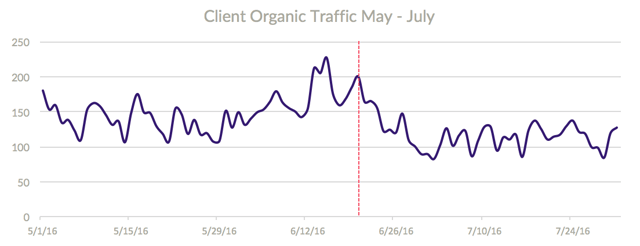Site Quality – Why It Matters and How You Can Improve It

Sure, you've heard the term "site quality," probably from an SEO on your team. You've probably even been told that one (or more) of your projects needs to improve its site quality. But what does it really mean, and how can you truly improve it?
Quality. People say it all the time—but what does it really mean to you, your site, and your business? You probably hear things like, “this page is thin and doesn't have great quality,” or “we need to improve content quality” from your SEO team. Those are both legitimate concerns, but how do you actually do them, and how can you determine whether it’s worth the effort?
That’s what I’m here to show you. I’ll go over a quick case study on quality, a brief introduction to Google quality updates and how Google uses quality to inform rankings, and what to do if you suspect you need to increase your site quality. Before we begin, let’s go over a high-level view of what “site quality” means.
What Is Site Quality?
Site quality is determined by Google to define the type of website that a user would want to use.
A high-quality website will have good content, a positive reputation, a minor amount of errors, good design, expertise, trustworthiness, and authority. A quality website doesn’t just tell the story of your product, it goes above and beyond by creating a quality experience that users (and Google) will trust.
Why Should You Care About Site Quality?
I’ve worked with an ecommerce site that was doing great in search, in fact, especially well for being a smaller player. They hadn’t paid attention to content that much, and were making changes based on CO & web features, so the site was constantly changing and being updated. Then, a potential quality update in June of ’16 came along.

There was an obvious dip in traffic, mainly to the homepage and a few key category pages, which made an impact on the bottom line. The revenue they were used to seeing was no longer there. These types of situations are when quality becomes a problem for the C-suite, creating immediate buy-in for SEO. Unfortunately, sometimes, despite how hard you try, securing buy-in is nearly impossible until a crisis occurs.
Through a multitude of SEO driven strategies, including moving to HTTPS, mass updates to product pages, additional content, improved indexation & crawling, and some off-site work, the site saw a bump with the potential quality update in early February.
We had been tracking a large group of keywords that were performing well, but no longer were. Below is the chart that shows the uptick in average rank that correlated with the update.

As a side note, the smaller dip and increase in the chart correlated with the Intrusive Interstitials Mobile Penalty. The site had a mobile pop-up and was updated late January. We didn’t see as much impact from this in GA or GSC, but the keyword movement leads us to believe the penalty did have some sort of impact.
Suspect you have been hit by an algorithm update? Google has hundreds of updates every year, and not everyone is announced or confirmed publically, so they’re easy to miss. You can follow resources such as Mozcast, Moz’s Algorithm Change History, or SEMrush Sensor to track changes in the algorithm. SEO experts on algorithm changes will generally publish their insights after a potential update to get an idea of what could have triggered the loss in traffic.
In this case, we knew it was related to site quality, so we utilized the Google quality rater guidelines as a basis to audit the site and prioritize updates to gain organic visibility back.
Google Search Quality Rater Guidelines
Google has full documentation on quality ratings and how to measure the quality of a website. I won’t go into full detail, since there are plenty of good summary articles already out there like:
- 30 Important Takeaways from Google’s Search Quality Rater’s Guidelines
- Updated Google Quality Rater Guidelines: No More Supplementary Content, Emphasis on E-A-T
- Updated Google Quality Rater Guidelines: Fake News, Dubious Claims & Clickbait Targeted
And, you can access the most recent leaked full documentation from Google here. The document is full of great information on how to set up your site to gain the best quality rating. It may take you a while to get through it, but it’s well worth the read. I recommend any new SEO read it fully, along with anyone actively working on a website. There are a few important takeaways to call out before we move on.
EAT – Expertise, Authority, Trustworthiness
Google uses the acronym EAT as the basis for consideration when determining a quality website. It walks through examples of different levels of quality and why it is ranked that way. We will be using their ratings in our quality audit template.
YMYL - Your Money or Your Life
It’s important to note that financial and health sites are held to an even stricter quality, since Google considers them YMYL (your money or your life) pages.
If you run an ecommerce or health site, you need to pay more attention to every piece of content and change you make to your website. If you’re in the ecommerce field, do your best to make your customers feel secure enough to purchase from your site, and if you’re in healthcare, be sure to reference studies and expertise of those providing the content.
Now that you know more about how Google determines quality, let’s review how to put that into use with a quality audit.
How to Improve Site Quality
So, you’ve bought into the idea of site quality and want to improve yours—now how do you do it? I’ve created a free template for you to download & use at your will. This is not a full technical or content audit – I’ve only included items that are focused on site quality. A full technical or content audit may cover all of this and most likely go more in-depth.
Follow these steps:
- Gather all the relevant data for every page on your website
- Use Screaming Frog to crawl every page on your site, with Google Analytics and Google Search Console API Data Connected
- Export the full crawl and input all fields within the correct columns in the template
- Use SEMrush to export all keywords for your domain. Add to the SEMrush current keywords tab. If you don’t have SEMrush, use Google Search Console to pull current keywords. The goal of this step is to identify what keywords each page could be ranking for.
- Audit every page
- Review all data when auditing each page. Look at the content, SEO content fields, current keywords, and analytics data.
- For each page, you should designate a quality score using Google Quality Rater Guidelines. Use the quality score to determine if the page should be updated or if it is good as is. Some key items to be sure to check from the Guidelines:
- Misspellings/grammar
- Word Count/thin pages
- Site security
- Trust signals
- Duplicate content
- Ads – too many, or impeding engagement
- Would you trust giving your money to this website?
- Sometimes you have too much experience with your website to give an unbiased score. It may be helpful to have a third party, or someone internal that doesn’t have as much experience with the website do the audit. You cannot afford to be too nice in this stage—we all know Google won’t hold back!
- Complete the site-wide audit tab
- The goal of this tab is to identify additional quality items that could be relevant on a site-wide basis rather than just on a page-by-page
- Review and prioritize your action plan based on level of effort and level of impact
- Consider your CMS capabilities, resources, and allocation when prioritizing the action plan
- Identify KPIs to measure impact
- Identify what to measure as a KPI for your updates. Understand how you will measure impact and report on your changes before you start making updates. This will give you an idea of how your changes are helping your website.
- Some things to consider:
- Rankings – Map target keywords to each page and set up tracking as a benchmark to watch
- Organic traffic – Use Google analytics organic sessions to identify improvements. Set up an automated report by page segments if needed using a tool such as Data Studio, Super Metrics, or Blockspring.
- Crawl Issues – Use Google Search Console or an automated crawling tool to monitor improvements to crawl errors
- Indexation – Use Google Search Console to monitor indexation of your XML sitemap and Indexation Status. This one is key if you had indexation problems identified during the audit.
- Work through completing your action plan, documenting any changes and tracking updates as you go. This will most likely require internal buy-in and take longer than expected.
- Monitor and adjust strategy as needed. A step that many easily lose sight of, it’s crucial to consistently measure findings and make adjustments as needed.
Incorporate the Full Team
Site quality isn’t just an SEO issue, and most changes don’t happen in an SEO vacuum. This will require cross-departmental teams and internal buy-in. Don’t hesitate to reach out to us if you’re looking for help with improving your site quality, and in turn, your bottom line.
<< Download the free template here >>

